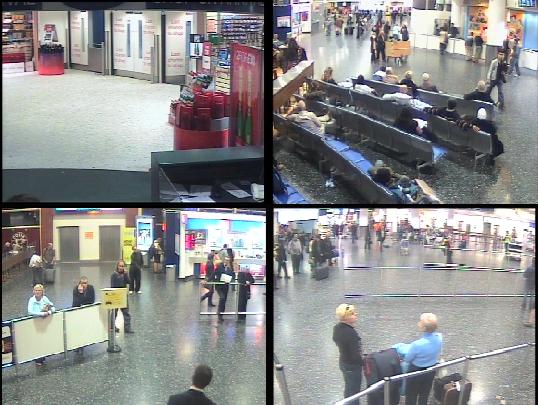In previous blog articles, I advocated using video monitoring technology in standard production operations. In writing these notes, I often wondered why this hasn’t happened already? The opportunity and benefits seem obvious and the costs are reasonable.
I never found a definitive answer, but I suspect that it may be tied to decision-makers’ expectations and assumptions about typical security system’s performance and cost. If I were to guess (and it is only a guess), I suspect that most people in operations would use their company’s security camera system as a point of reference. I further suspect that most assume that their company system is pretty decent. So, they think they will see a view of on-floor operations that is something like the image below. One can understand how that might not be exciting. Further, if they persevere to investigate the costs, they will probably find that their plant video security system wasn’t that cheap and it was perhaps a pain to install.

Well alrighty then … forget that idea.
The problem with this understandable comparison lies with the fact that your facility security system was probably installed a number of years ago. Video surveillance technology has made enormous, nearly unbelievable strides in the past 5 years. The following diagram is my attempt to break down the magnitude of this shift … and to factor in the less stringent installation demands for a system that only needs to focus on internal operations.

There are four main change areas to consider.
- The first is the fact that an indoor, operational surveillance system is a lot simpler and easier to install. You don’t need vandal-resistant housings or armored cabling conduits. You also probably don’t need to mount cameras up high or punch holes through brick walls. You can use less rugged cameras with simpler mounts. A simple clamp may do. Overall, that has to save at least half of the installed cost.
- Cameras now run at higher frame rates. With a continuous 60 frames/second video feed, you can take normal surveillance footage and do serious slow motion studies … after the fact … and no special equipment is needed. That’s four times faster than older systems, but who knows how much operational value that might reveal. I think this will be a four fold value gain when people understand the full implications.
- Camera resolution is now available at the 8 megapixel (4K video) level. That means far more detail and the ability use a “digital” zoom … again after the fact. You don’t have to plan to get a closeup. The closeup is baked into the recorded video feed. You won’t need as many expensive Pan-Tilt-Zoom cameras and you can probably reduce the number of cameras overall. Between the extra resolution and the extra simplification, I credited the full 8x value gain.
- Video camera costs have fallen about 20% per year over the past 7 or 8 years. That’s been true for both HD cameras and 4K ultraHD cameras. My saying that the 2017 system will cost half as much as the same capability in 2012 is very conservative.
Put all of these together and it seems plausible to claim that the operational surveillance system will deliver as much as 100 times the bang for the buck as the 5 year old facility security system you are subconsciously comparing it to. I know there are lots of assumptions and lots of room to quibble with my numbers, but by any reasonable analysis, the difference will be BIG!
So, if the thought of using a video surveillance system to study operations has occurred to you and you dismissed it because you’ve seen the company’s security system and you aren’t impressed, it might be time to revisit the idea … with state-of-the-art designs and costs.
Just sayin.

